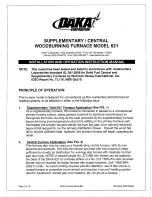
HANDY HINTS
- The hose connections, cylinder valve outlet
connection and appliance inlet connection
should be kept clean. If grit or dirt is present
when the connections are made, the rubber
seals at each end of hose may be damaged.
- To clear blocked jets wash in petrol (be sure to
dry thoroughly before lighting stove).
DO NOT
use wires or prickers. If washing is
unsuccessful, fit new jet.
- Check for gas leaks with
SOAPY WATER
.
DO NOT USE A FLAME.
- Ensure that the area in which the appliance is to
be used is well ventilated and
DO NOT
use as a
space heater in tent, caravan, etc.
- Ensure the appliance is completely
extinguished before disconnecting from the
cylinder.
-
DO NOT
place the appliance closer than 60cm
from ceiling or flammable material.
- Avoid moving the appliance during use as this
can cause large flames.
- Allow the appliance to cool down after use
before touching the burners, trivet, windshields
or folding up for transportation.
SAFE APPLIANCE LOCATIONS
This appliance shall only be used in an above ground open-air situation with natural ventilation, without
stagnant areas, where gas leakage and products of combustion are rapidly dispersed by wind and natural
convection.
Any enclosure in which the appliance is used shall comply with the following:
An enclosure with walls on all sides, but at least one permanent opening at ground level and no overhead
cover (see Example 1).
Within a partial enclosure that includes an overhead cover and no more than two walls (see Example 2 & 3).
Within a partial enclosure that includes an overhead cover and more than two walls, the following
will apply:
At least 25% of the total wall area is completely open, and at least 30% of the remaining wall area is open
and unrestricted (see example 4 & 5).
In the case of balconies, at least 20% of the total wall area shall be and remain open and unrestricted.
DIAGRAMMATIC REPRESENTATIONS OF OUTDOOR AREAS
The following figures are diagrammatic representations of outdoor areas. Rectangular areas have been
used in these figures – the same principles apply to any other shaped areas.
LIGHTING & BURNER ADJUSTMENT
1. Open the cylinder control valve about one full
turn.
2. Each burner can be operated independently by
turning the control valve on (rotating the knob
anticlockwise about one turn) and, applying a
lighted match on the burner or pushing piezo
igniter until burner lights (for piezo version) the
flame can be regulated by opening or closing
jet blockage.
3.
IMPORTANT:
When turning the appliance off
at completion of use, the gas supply should be
first turned off at the cylinder, and all gas in the
hose burnt away before closing the valves on
the stove. Leaving gas in the hose can cause jet
blockage.
ANNUAL MAINTENANCE
Clean the body of your appliance using a cotton
cloth soaked in soapy hot water. Never use
abrasive or flammable cleaning products. Use a
soft brush to clean the burner.
STORAGE
When the appliance is not used it must be stored
in a suitable area to protect it from any risk of
deterioration. Keep it in a well ventilated area and
out of reach of children.
Open Side at least 25% of total wall area.
30% or more in total of the remaining wall area
is open and unrestricted.
Example 1
Example 2
Example 4
Example 5
Open Side at least 25% of total wall area.
30% or more in total of the remaining wall area
is open and unrestricted.
Example 3
Both ends open
INSTRUCTIONS
Read these instructions for safe use. familiarize yourself with the appliance before connecting it to
gas supply. Keep these instructions for future reference.
1. Remove appliance from carton and remove any
transit protection material.
2. Open the lid to the vertical position, fold out the
windshield and engage the clips with the slots
in the side of the body.
3. Lift the front edge of the wire trivet to remove
the hose from its storage position and replace
the trivet. Check the “O” rings for any damage
before connecting hose. Connect the hose to
the appliance by pushing the hose fitting into
the inlet connector, then tightening the knurled
nut until hand tight and firm.
4. Check that the control valves for the burners are
turned OFF (clockwise for off).
5. Connect the hose to the gas cylinder and use a
spanner to tighten firmly.
6. Ensure the metal feet are in position to
maintain clearance between the appliance and
the support surface and for good airflow and
correct operation.
This appliance should only be operated on a hard,
flat, level surface.
a.)
The appliance area must be kept clear and
free of combustible materials, gasoline and
other flammable vapors and liquids.
b.)
Gas orifices and burner must be kept clear
of dirt and cobwebs. Flow of combustion and
ventilation air through the perforated portions
of the appliance must not be obstructed.
c.)
Any cleaning agent used on the appliance
should be of a non-corrosive and non-
combustible nature.
7. Proper clearance from combustible materials
must be maintained at all time. The minimum
clearances are as follows:
Minimum Clearance from Combustibles:
Side
600mm
Top
600mm
Combustible materials are considered to be wood,
compressed paper, plant fibers, plastic, plexiglas
or other materials capable of being ignited and
burned.
Such materials shall be considered combustible
even though flame proofed, fire-retardant treated
or plastered. Additional clearance may be required
for glass, painted surfaces and other materials which
may be damaged by radiant or convection heat.




















